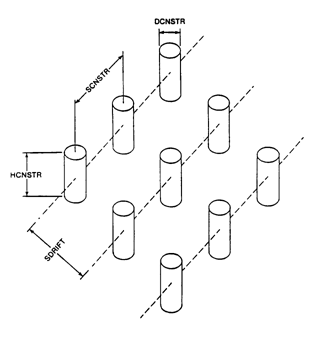
Four different physical properties
are taken to be functions of global rock type, namely thermal conductivities,
dispersivities, distribution coefficients and salt-dissolution rates. Thermal
conductivities and dispersivities are read by READ1 and distribution coefficients
by READ0. Here, as a part of the input to READ1A, the rock-type specification
and the salt dissolution rates are prescribed. In addition, all of the
parameters defining the waste-leaching process within the repository are
specified by the R1A input data set.
6.1 PRESCRIPTION OF ROCK TYPES AND
SALT-DISSOLUTION CONSTANTS
If NRT = 1, skip to READ R1A-2 since all blocks are assumed by default to be of Type 1. Otherwise enter the desired number of changes, terminating with a blank record.
READ R1A-1
(7I5) Modification of Rock Types.
J1A, J1B (Similar definition for the J index).
READ R1A-2 (7E10.0) Salt-Dissolution Coefficients.
6.2 DEFINITION OF THE REPOSITORY
PARAMETERS
The user should skip to READ R2-1 if NREPB = 0. If NCP = 0 and NREPB … 0, skip to READ R1A-5.
READ R1A-3 (I5) Waste Type.
0 - The waste-volume density is to be input directly.
1 - Canistered-storage data is to be
input and used internally to calculate the waste-volume density.
DCNSTR For canistered wastes (ILEVEL = 1) DCNSTR is the diameter of each canister, ft (m). For uncanistered wastes (ILEVEL = 0) DCNSTR is the volumetric waste density (volume of wastes per bulk volume of repository blocks).
HCNSTR Canister height, ft (m). Used only for storage of canistered wastes.
Arbitrary units may be used above and then converted to the English Engineering System (SI System) via R1A-5.

READ R1A-5
(4E10.0) UNIT Conversions.
CONVC This parameter multiplies the waste concentrations (R1A-8) to convert to lb/ft3 (kg/m3).
CONVT This parameter multiplies the given interpolation times (R1A-7) to convert to days (seconds).
CONVH This parameter multiplies the repository heat loadings (R1A-8.5) to convert to Btu/ft2-d (J/m2-s).
The default value for CONVL, CONVC, CONVT and CONVH is one. Thus, a blank or zero input value is reset to unity.
READ R1A-6 (6I5) Repository Location.
J1A, J1B (Similar definition for the J index).
K1A, K1B (Similar definition for the K index).
The repository blocks are assumed to be contiguous. Thus, only one input record R1A-6 is permitted, and no terminating blank record is necessary.
READ R1A-7
(7E10.0) Interpolation Times.
Arbitrary units may be used here and then converted via CONVT (READ R1A-5) if desired.
The user must enter NCP groups of records below. However, the information will be used only for those components being tracked within the entire global system, i.e., the information will be used only if CNAME below matches one of the DI identifiers (READ R0-1).
READ R1A-8 (2A4,2X,6E10.0/(7E10.0)) Interpolation of Unleached Concentrations.
CNDUM If interpolation is to be used, then CNDUM represents the concentrations at the interpolation times expressed as mass per unit volume of waste. If interpolation is not used, then CNDUM(1) is the initial condition for the chain decay.
If KHEAT = 0, skip to READ R1A-9.
READ R1A-8.5 (7E10.0) Repository Heat Loadings.
If NCP = 0, skip to READ R2-1.
READ R1A-9 (7E10.0) Solubility Limits.